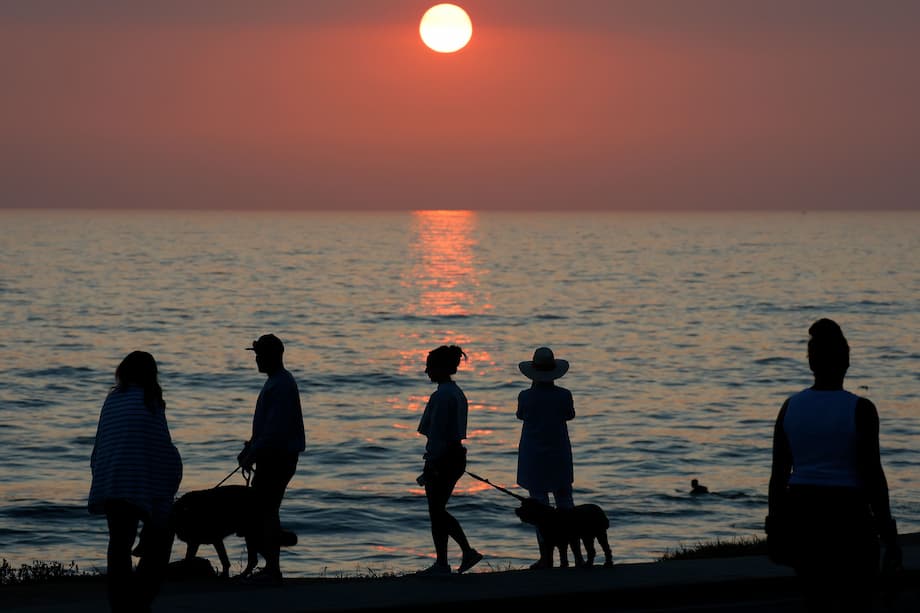A basin wide heat wave from Japan to California
A vast marine heat wave is unfolding across the North Pacific, stretching roughly five thousand miles from waters near Japan to the West Coast of the United States. Sea surface temperatures across this basin ran far above average in late summer, breaking records for August that go back to the late nineteenth century. The scale, intensity, and reach of this event set it apart. It is already shaping weather on land and tightening pressure on marine life from plankton to whales.
- A basin wide heat wave from Japan to California
- How a marine heat wave forms
- Weather impacts from Tokyo to California
- Ecosystems under pressure
- Scale and records across the Pacific
- Beyond the surface: sea level, coral, and coastal risk
- Forecasts and what might change this fall
- What communities and industries can do now
- Key Points
Japan endured its hottest summer on record, including a national high of 41.8 degrees Celsius (107.2 degrees Fahrenheit). Across the Pacific, northern California has felt unseasonably muggy air at the start of meteorological fall as warmer waters boost evaporation. If the warmth lingers into winter, meteorologists warn it could prime the region for stronger atmospheric rivers, with heavier rain and deeper snow in mountain ranges.
What alarms scientists most is the repetition. Ocean warming has accelerated since 2023, and the share of the global ocean in a heat wave reached unprecedented levels. In January 2024, more than 40 percent of the ocean surface qualified as being in marine heat wave conditions by common thresholds. This event adds to that trend, and the North Pacific stands out as a hotspot.
A step change in ocean heat since 2023
Marine heat waves are periods when ocean temperatures stay far above a local baseline for extended days or weeks. The most widely used benchmark flags a heat wave when the water is warmer than 90 percent of historical values for that time of year, typically for at least five consecutive days. Since early 2023, the global ocean has been running unusually warm, and heat waves have multiplied in duration and extent.
Senior experts tracking the Pacific warn that a warmer baseline raises the floor for every future event. One of the leading researchers, a senior scientist at the National Oceanic and Atmospheric Administration (NOAA), summed up the concern. He said:
“The North Pacific has a fever, but the story does not end there. The downstream effects of these marine heatwaves is likely to be significant in terms of how they impact marine organisms, ecosystem structure, fisheries and the weather in the Pacific Northwest.”
The speed of warming in the North Pacific during the past decade has outpaced other ocean basins. That helps explain why events once considered rare are happening again within just a few years.
How a marine heat wave forms
Warm anomalies at the surface can build when winds weaken or shift in ways that reduce the upwelling of cold, nutrient rich water from below. Persistent patterns of high and low pressure can stall over the ocean and steer winds that discourage vertical mixing. When upwelling is curtailed, the thin upper layer of the ocean heats rapidly in summer sunlight. Without strong winds and waves to churn that heat downward, the surface can stay warm for weeks.
Why the North Pacific keeps warming fastest
Scientists point to a one two punch. Human driven greenhouse gases have raised the background temperature of the ocean, and natural swings in winds over the basin during spring and summer have, in recent years, favored reduced upwelling. That combination loads the dice toward more frequent and larger heat waves in the region.
Surface based or deep rooted warmth
Whether a heat wave stays shallow or sinks deeper matters. A shallow, summer focused event tends to fade once autumn storms reintroduce mixing. An oceanographer at the Scripps Institution of Oceanography explained that this year’s Northeast Pacific warmth appears concentrated near the surface. He said:
“Since this is a summer anomaly, it is very likely confined to a very thin mixed layer depth. So once the atmospheric conditions change, it should fade quickly into the ocean via vertical mixing and through losing heat to the atmosphere.”
By contrast, the prolonged 2013 to 2016 episode pushed warmth deep into the upper ocean, which helped it survive through stormy winters. Depth and duration are critical differences that determine both ecological impacts and seasonal weather effects.
Weather impacts from Tokyo to California
Marine heat changes the way the atmosphere behaves above it. Warm water adds moisture to the air and can alter pressure patterns that steer storms. Around Japan, the extraordinary ocean warmth added fuel to heat on land and contributed to extreme summer conditions. Across the North Pacific, the current event is large enough to stand out on hemispheric weather maps, and specialists are watching for downstream signals in North America.
A climate scientist at the University of California, Los Angeles, described one key risk if the warmth persists through autumn. He said:
“If the broad ocean basin wide heat wave persists, it could influence the wintertime storm track associated with the jet stream.”
For the U.S. West Coast, that could translate into storm paths that favor stronger atmospheric rivers. Warm water does not guarantee a wet winter, but when storms do arrive, a moist background state can increase rainfall rates and raise the odds of higher elevation snow. In California, warmer coastal waters have already nudged dew points higher, leading to sticky nights and smaller swings between daytime highs and overnight lows.
Jet stream and interior North America
Farther inland, such as in the Upper Midwest, researchers are monitoring whether the warm pool will nudge the jet stream in ways that can produce a colder and snowier winter. Past warm blob events have coincided with unusual winter patterns over the continent, but outcomes vary. Minnesota, for example, has lived through both harsher winters and milder ones in different years with North Pacific anomalies. Specialists caution that the exact placement and endurance of the heat wave, along with other influences like the tropical Pacific, will shape the final outcome.
Ecosystems under pressure
Marine heat waves strain ocean life at every level. Warm, stratified surface waters hold fewer nutrients, stifling the growth of phytoplankton that form the base of the food web. A global study using Biogeochemical Argo floats shows that heat waves do not just affect the surface. In many mid and low latitude regions, surface plankton decline while subsurface layers see an increase in biomass because nutrients and light shift vertically. This reshuffling can decouple what satellites see at the surface from what is happening just below, and it can ripple through food chains in complex ways.
Coastlines already know the stakes. The last extended Northeast Pacific heat wave pushed thousands of species to move in search of cooler water. Forage fish like anchovies and sardines shifted, contributing to the starvation of seabirds and marine mammals. Toxic algal blooms became more frequent and intense in the warm, nutrient poor conditions, closing crab and shellfish fisheries and costing coastal economies tens of millions of dollars.
Alaska’s living ledger
The Alaska Maritime National Wildlife Refuge has seen lasting fallout from past events. A supervisory wildlife biologist there described how seabird populations have struggled to recover and reported fresh signs of stress this summer. She said:
“There have been multiple die offs of marine mammals, seabirds and forage fish in Alaskan waters this summer; we have definitely had an uptick in calls from the public about sick and dead birds.”
Long term impacts are also showing up higher in the food web. Recent drone based measurements of resident salmon eating killer whales in the Gulf of Alaska suggest females that grew during the 2014 period reached smaller adult sizes. Smaller whales carry less energy reserves and are more vulnerable during lean times, affecting reproduction. Researchers documented new calves this summer, a hopeful sign, yet they warn that another extended heat wave or a drop in salmon could strain the population again.
From plankton to predators
Scientists are now documenting how heat waves reshape the vertical structure of phytoplankton, which can intensify at depth even as the surface thins out. That shift changes when and where grazers like krill can feed, which then alters feeding opportunities for fish, birds, and whales. After the mid 2010s event, humpback whale sightings in parts of the North Pacific fell by roughly 20 percent over several years as prey collapsed. Studies show that ecological effects can linger long after the heat subsides, a warning that brief looking events may still leave deep marks.
Scale and records across the Pacific
Fresh analysis of the South West Pacific in 2024 underscores the scale of what is unfolding. A report from the World Meteorological Organization found that marine heat waves affected about 40 million square kilometers of ocean in the broader region during several months of the year. That is more than ten percent of the global ocean surface. The region ran about 0.48 degrees Celsius above the 1991 to 2020 average, with many countries setting new annual heat records on land.
The heat in the ocean has real costs. The Philippines endured an unprecedented late season cyclone burst with a dozen storms between September and November 2024, affecting more than 13 million people and displacing at least 1.4 million. Australia’s winter snow season ended early. Coral reefs across the region suffered another mass bleaching, including the fifth mass bleaching on the Great Barrier Reef since 2016.
The World Meteorological Organization’s secretary general warned that communities stand on the front line of ocean change, with rising seas and hotter water combining to stress food systems, livelihoods, and culture. She said:
“Sea level rise is an existential threat to entire island nations and time is running out to turn the tide.”
Satellite measurements show sea level in parts of the southwest Pacific rising faster than the global average. Warmer water expands, a process called thermal expansion, and that has recently been a major driver of sea level rise. In some island communities, repeated flooding and erosion are forcing discussions about relocation, with difficult cultural and spiritual choices for families tied to ancestral land.
Beyond the surface: sea level, coral, and coastal risk
Hotter oceans do more than bleach corals. They also shift currents, raise sea level, and influence storm behavior. Rapid intensification of tropical cyclones becomes more likely over warm pools of water, which can increase the destructive potential of storms that reach populated coasts. At the same time, higher baseline sea level pushes storm surge farther inland and worsens tidal flooding on clear days.
Coral bleaching stands as one of the most visible signals. When water stays too warm for too long, corals expel the algae that feed them, turning white. Bleached corals can recover if temperatures drop fast enough, but repeated events drain their reserves. With heat waves appearing in more seasons and at greater intensities, reefs are facing shorter recovery windows. Reefs protect shorelines, nourish fisheries, and support tourism, so their decline carries direct costs for coastal communities.
Forecasts and what might change this fall
Short range marine heat wave outlooks point to continued concern across parts of the North Pacific. Forecast bulletins show the warm pool near 30 degrees north expanding and intensifying, with the category of extreme heat emerging in the Bering Sea. In the Northeast Pacific, the evolving depth of the warm layer will determine how quickly autumn storms can mix away surface heat. If early season winds strengthen, the shallower parts of the heat wave should weaken. If winds remain light or storms miss the region, warmth could linger longer along the West Coast.
Many moving parts matter at once. The state of the tropical Pacific, the position of the North Pacific high, and the timing of early winter storms will shape the outcome for California, the Pacific Northwest, Alaska, and Canada. An event of this size can also feed back on the atmosphere, so forecasts will remain a close call week by week.
What communities and industries can do now
Preparation and fast information help reduce damage even when the ocean stays hot. Coastal fisheries can adjust seasons and quotas in real time to avoid over stressing vulnerable stocks. Managers can set vessel speed reductions near whale feeding zones and expand monitoring to reduce ship strikes when animals crowd into remaining cool pockets. Early toxic algae testing can warn crab and shellfish operations ahead of closures. Public health alerts can reduce risks for beachgoers and seafood consumers during harmful algal blooms.
Early warning pays off
Recent case studies show that early warnings and anticipatory actions save lives and livelihoods. In the Philippines, improved alerts helped communities prepare for back to back storms during the record late 2024 cyclone surge. The approach included tailored forecasts, pre positioning supplies, and rapid evacuations. Similar principles can help coastal towns respond to flood threats tied to higher sea level and storm driven surges.
Local choices matter too. Restoring kelp forests and seagrass beds can improve habitat and carbon storage, while easing other pressures like overfishing and pollution gives ecosystems a better chance to cope with heat stress. These steps do not replace the need to cut greenhouse gas emissions, but they can reduce the toll of marine heat while the world works on the larger climate problem.
Key Points
- A record breaking marine heat wave now spans the North Pacific from Japan to the U.S. West Coast, with August anomalies setting basin wide records.
- Japan logged its hottest summer on record and parts of California saw higher humidity and warmer nights linked to the warm ocean.
- Scientists warn the North Pacific has warmed faster than other basins in the past decade, raising the odds of frequent large heat waves.
- Weak upwelling and persistent pressure patterns helped build a shallow but extensive warm layer that could fade if strong autumn storms arrive.
- If the warmth endures, it may influence the winter jet stream and atmospheric rivers that affect the U.S. West Coast.
- Ecological stress is mounting, from seabird die offs and whale food shortages to harmful algal blooms and coral bleaching.
- WMO reports that about 40 million square kilometers of ocean in the broader Pacific region saw marine heat waves during 2024.
- Sea level rise, driven in part by thermal expansion, adds risk to island nations and low lying coasts during storms and high tides.
- Forecasts show intensifying anomalies in parts of the North Pacific and the Bering Sea, while mixing may erode shallow warmth in the Northeast Pacific later in fall.
- Fisheries management, early warning systems, and habitat restoration can reduce near term damage while emissions cuts address the root cause.




